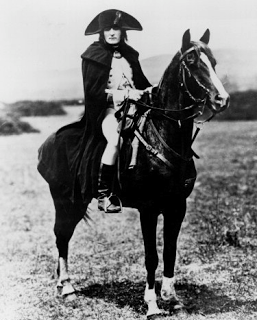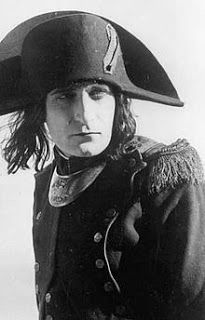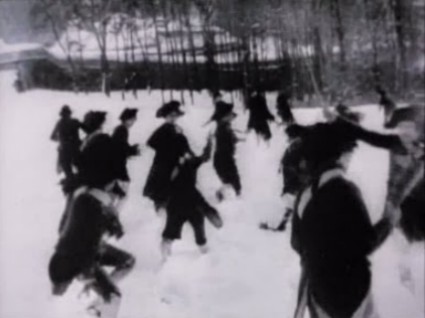With the news of the big-screen showing of Abel Gance’s 1927 silent masterpiece Napoleon at the San Francisco Silent Film Festival coming up, I thought this would be as good a time as any to re-visit this incredible film that really qualifies as a viewing “experience”, in the truest sense of the word.
Profound in its ambition, scope and technique, Napoleon was the pet project of French filmmaker Abel Gance, who sought to tell the life story of Napoleon Bonaparte, initially over the course of several films.
In the process of filming the incredibly complex and costly endeavor, Gance’s plans for multiple films about Napoleon failed to materialize, but the one he ended up with – which covers everything from Napoleon’s childhood years at school through the Italian Campaign – remains one of the most staggering works the medium has ever produced.
I was fortunate enough to catch a rare TV screening of Napoleon on the A&E Network’s “Breakfast with the Arts” in 1993, when I was only nine years old.
Even then, watching it on a too-small TV with commercial breaks, it made a tremendous impression on me. Like The Birth of a Nation, Battleship Potemkin or Citizen Kane, the film is a veritable textbook of cinematic technique.
 Gance utilized a number of then-unconventional techniques, including hand-held camera, rapid montage editing, and even widescreen. (Gance reportedly shot footage in 3D as well, but was unable to use it.)
Gance utilized a number of then-unconventional techniques, including hand-held camera, rapid montage editing, and even widescreen. (Gance reportedly shot footage in 3D as well, but was unable to use it.)
There’s a particularly thrilling sequence toward the beginning of the film in which Napoleon is chased on horseback; Gance and his camera crew actually mounted the camera on horseback to achieve an incredible sense of movement and action.
In many ways, the film’s opening sequence remains one of its most celebrated: a large-scale snowball fight between two teams of students, in which the young Napoleon first demonstrates his future skill in battle.
Gance starts the film off with a sequence that immediately shows the viewer that this will be no ordinary film – from the use of handheld camera, extreme close-ups, even pulling the cameraman on a sled in order to achieve a tracking shot through the barrage of snowballs.
This sequence also introduces the incredibly rapid editing that moves images so quickly before the viewer’s eye that the individual shots become impossible to perceive.
Much of Gance’s technique owes something to the French avant garde movement of the period.
Gance’s previous work, such as J’accuse (1919), demonstrated elements of avant garde influence, such as the sequence in which the ghosts of dead soldiers return from the battlefields to accuse the citizenry of complacency. The French cinema was incredibly rich with avant garde artists and filmmakers during this time, from Man Ray to Jean Epstein, Rene Clair, and (a little later) Jean Renoir. Gance’s work is unique in that incorporates the tradition of the French avant garde into the mainstream, narrative feature format.
The story of the film’s production is legendary, and is covered well by Kevin Brownlow in his book “Napoleon” (British Film Institute: 2008) which explores the vast production of this epic.
 What’s remarkable is how well the film manages to blend both jaw-dropping technique and intimate character study.
What’s remarkable is how well the film manages to blend both jaw-dropping technique and intimate character study.
Albert Dieudonne’s portrayal of Napoleon is captured with fierce intensity and even surprising moments of humor, making it a fully-rounded portrayal.
After its initial release, Napoleon underwent many transformations and alterations under the supervision of its director, Abel Gance, who re-cut the film several times.
As a result, the director’s original cut becoming something of a “lost” film. When Kevin Brownlow began his restoration on the film, he had little to go on, but subsequently has restored the film to close to its full glory.
His 1979 restoration was shown at the Telluride Film Festival.
Fortunately, Abel Gance was still around to listen to the applause from the audience over a telephone. Subsequent restorations have brought it closer and closer to Gance’s original vision.
Napoleon holds up more than 80 years after its initial release as one of the most ambitious works of art ever created in the cinema. Its techniques have been tremendously influential on contemporary film, although many of these techniques are still ahead of their time. It’s a testament to the vision of director Abel Gance that he was able to mount such an epic production that still manages to maintain a strong focus on historical events and characters.
Napoleon is one of the most important single works in the history of the medium.













































































































